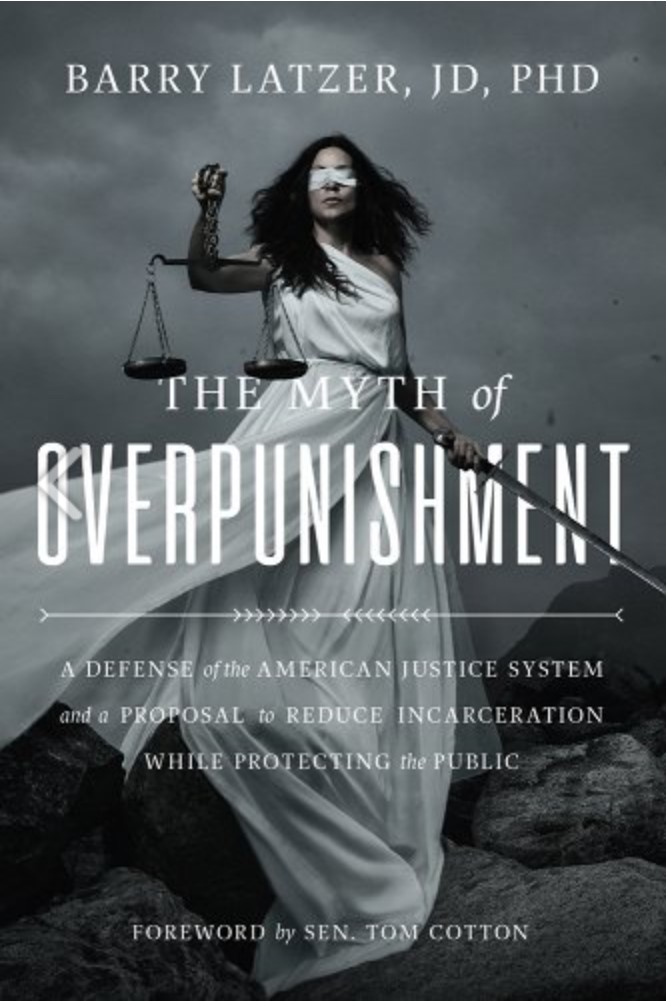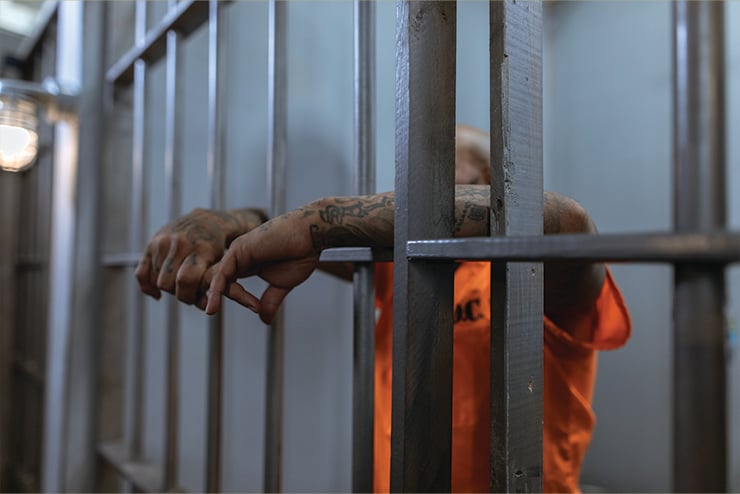
The Myth of Overpunishment
by Barry Latzer
Republic Book Publishers
208 pp., $24.95
More than 30 years ago, a young woman who had recently been the salutatorian in her high school graduating class was raped and murdered in her office at the business college where she worked. Her killer, a student at the college, told the court at his trial that he had planned her rape for months after becoming acquainted with her. She screamed as he beat her viciously. He then strangled her, first with his hands, then with his belt. When his belt broke, he used hers to finish the job.
This woman, my high school classmate and friend, was 23 years old. She had been married for just 18 months at the time of her death.
The murderer was sentenced to 30 years to life, and he sought parole at the first opportunity. He was denied. But many leaders of our culture have of late become decidedly hostile to the idea of vigorously punishing criminals, especially those, like the one who murdered my friend, who are black. It is possible that the author of this monstrous act will secure release before the end of his life.
Many other savage criminals are released from America’s prisons every year. Many more never even make it to prison in the first place, because of the tremendous influence of activists and their political allies who allege we “overpunish.” Radical criticism of our criminal justice system has become ever bolder over the past few decades. Arguments for the abolition of prison are commonplace on college campuses and in the pages of the nation’s newspapers.
Barry Latzer, an emeritus professor of criminal justice at John Jay College of Criminal Justice, has written a muscular response to these radicals in The Myth of Overpunishment.
The first half of the book deals with the history of punishment in America. Early on, it was often straightforwardly vicious. From the colonial era through the 19th century, punishment typically entailed intensely cruel public spectacle. As “colonial maim-and-shame” gave way to the prison system, brutality remained the norm. Latzer describes the “shower bath”—an early form of waterboarding—as a frequent punishment in the early prison system.
The convict lease system and the chain gang were common features of punishment in the post-Civil War South. Latzer recounts the case of an early 20th-century black Alabama prisoner, Green Cottenham, imprisoned for vagrancy and subsequently forced to labor in a mine shaft. Leased to a coal company, Cottenham worked in conditions certainly as terrible as those faced by many who were enslaved before 1865. His daily quota was eight tons of shoveled coal. His jailers whipped him mercilessly if he did not meet it, or if he otherwise displeased them.
The 20th century saw the birth of the progressive approach to punishment, which purported to apply scientific principles to the field. Efforts to discover—and sometimes to invent—ways in which mental pathology produced crime increased. Sterilization of the “criminogenic” became a tool in the punitive apparatus. Beyond this pseudo-scientific social Darwinism, the rise of progressivism also meant the gradual turning away from brutal punishments and toward more supposedly humane methods of dealing with crime.
Progressive critics pushed the death penalty, which had long experienced a steady decline over the course of the country’s history, to near extinction. Corporal punishment, too, basically disappeared, as distaste for the public spectacle of pain grew. Forced labor was also eliminated, replaced by paid work for prisoners, which often involved basic maintenance of the prisons.
Around the time of these progressive innovations in criminal justice, American crime rates were beginning a historic rise. From the end of the 1960s through the mid-1990s, we experienced what Latzer vividly calls a “crime tsunami” in which violent crime rates reached all-time highs. The Myth of Overpunishment makes a compelling case that leniency in punishment contributed to the rise of this wave, and that a temporary return to rigorous incarceration helped end it.
The tsunami was truly astounding in its volume and its ferocity. By the early ’70s, Gallup polls showed that four in ten Americans were afraid to walk in their neighborhoods at night. More Americans—in excess of 540,000—were murdered during this crime wave than died in World War II and the wars in Korea, Vietnam, Iraq, and Afghanistan combined.
The contrast is even more astounding if one looks at those injured in criminal assaults during that period. Perhaps a million American soldiers were wounded in all those wars just cited. More than two times that number were victims of violent crimes during the crime wave … every single year for a quarter century. The financial costs to the victims of all this crime were in the billions of dollars. As Latzer puts it, “The crime tsunami was a war on the American civilian population.”
Leftist scholars bend themselves into surrealist pretzels trying to deny any possible inverse relationship between punishment and crime. But the evidence shows that rates of conviction and time spent in prison by perpetrators were decreasing at the beginning of the crime tsunami. And the rise of incarceration rates and time spent in prison correlate with the onset of the crime wave’s decline.
Latzer acknowledges that incarceration rates continued to grow after the mid-’90s, when crime rates started to fall. This fact provides legitimate space for criticism of the American justice system. But it must be contextualized within the massive crime wave that gave rise to it, which only abated after that increase in punitive intensity. The phenomenon that decarcerationists pejoratively describe as “mass incarceration” was a reasonable response to the crime tsunami.
Latzer gives us a sustained critique of some of the best-selling popular books by decarcerationists. Notably, he eviscerates Michelle Alexander’s 2010 book, The New Jim Crow: Mass Incarceration in the Age of Colorblindness. Alexander claims the trend in incarceration targets drug offenses and that most blacks in the criminal justice system are there for nonviolent drug crimes. In fact, only a quarter of black inmates in state prisons, which hold 90 percent of all prisoners, were convicted of drug offenses.
Decarcerationists like Alexander ignore high black crime rates or pretend black overrepresentation in prison is caused by racist policing. Victim surveys, however, show the same disproportionate presence of blacks among perpetrators. There are no evident reasons for crime victims to misrepresent the race of their assailants, especially in the case of equally disproportionately represented black victims.
It will take some intense work to effectively argue that we imprison too many if we look even briefly at the quantity of unpunished crime. Just taking four particularly egregious forms of violent crime—murder, rape, robbery, and aggravated assault—we find startlingly low conviction rates. More than half of murderers are never imprisoned. Almost 95 percent of those who commit the other three crimes similarly escape unpunished.
Nearly six in ten inmates in state prisons are there for violent crimes. Large numbers of the others are serving time for crimes indicating substantial risk to public safety: weapons offenses and drunk driving, for example. The prison population is largely the worst of the worst among criminal offenders, and most are repeat offenders. Latzer presents a sample of 400,000 prisoners freed in the U.S. in 2005 that had a total of more than 4 million previous arrests between them, or an average of about 10 per individual. To imagine these people could be released without an inevitable cost to innocent civilians is to admit residency in cloud-cuckoo-land.
Prison abolition is a dangerous hallucination. But those who advocate for decreasing incarceration rates are a broader group than this radical fringe. On the left, advocates invoke justice for that minority of prisoners spending long periods locked up for nonviolent drug offenses. On the right, they point to the extravagant costs of such incarceration.
Latzer makes a measured case for increased use of electronic monitoring of offenders, or “e-carceration,” as a possible way forward. He admits its significant weaknesses. If punishment aims for some combination of incapacitation, general deterrence, and retribution as its goals, then e-carceration is deficient compared with traditional incarceration on all three scores. But Latzer believes it will get more effective at the first two as the technologies improve. Better audio and visual tracking devices will make it less likely that offenders are able to engage in illegal activities without the knowledge of monitoring authorities. Of course, questions of the invasion of the privacy of innocents who happen to be in the offender’s vicinity will concomitantly increase. E-carceration is a comparatively low cost method. But it can probably never be effective with violent offenders, who, again, are the majority of those currently in prison.
There is some evidence that e-carceration reduces recidivism. It might well be a morally superior alternative to prison by those firmly committed to openness to the possible repentance and reform of the criminal. Those who emphasize the retributive side of punishment, however, will likely be unimpressed. In this view, the criminal must be made to pay for his act, whether or not such retribution is effective at reforming him. Other critics will see dangers in the possible compromising of Fourth Amendment rights.
Latzer may be right. E-carceration may be the future. It does seem a legitimate consideration for low-risk, nonviolent offenders. But whether it can help stem the tide of the more radical decarceration movement among cultural elites is far from clear.

Leave a Reply